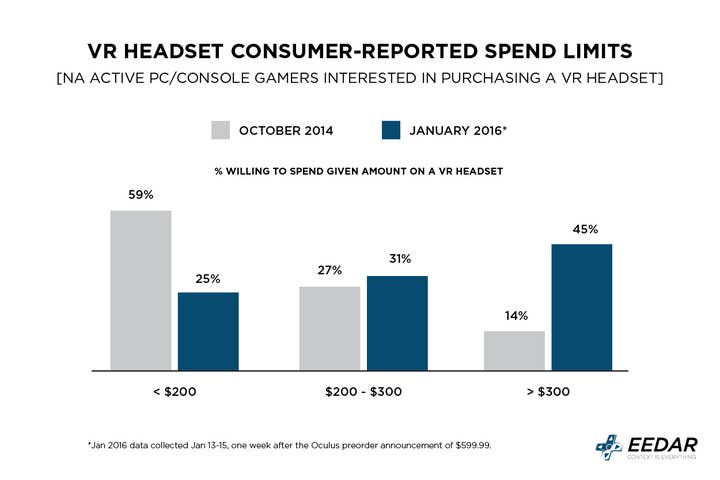The Cost of VR: a Consumer Response
Eedar's Patrick Walker analyses the public's reaction to VR hardware
On January 6th, Oculus launched its preorder campaign and started the "year of VR" in earnest with the first price announcement for a high-end VR headset. After months of consumer and analyst speculation and very little comment from the major hardware manufacturers on headset pricing, Oculus announced a launch price of $599.99, higher than what was expected by many consumers. The messaging strategy for Oculus quickly became clear, with founder Palmer Luckey emphasizing that Oculus had committed to the path of "prioritizing quality over cost, trying to deliver the best VR experience possible with current technology."
HTC is taking a similar quality-first messaging strategy, announcing in December that not releasing in 2015 was the result of "a very, very big technological breakthrough." And while many assume that Sony will have the cheapest of the three headsets, Sony has not officially revealed many details on the price and hardware specs of the PlayStation VR.
So where does this put consumers as they wait for the next major announcement? Here are four takeaways from an analysis of consumer awareness and sentiment conducted a week after the price announcement:
1) Oculus has gained a significant lead in gamer awareness by consistently being a frontrunner in VR product announcements and news.

Oculus has been in the forefront of VR news since it launched its August 2012 Kickstarter campaign and quickly reached its funding goal. It can be argued that VR finally reached a mainstream awareness when Facebook purchased Oculus for $2BN in March of 2014. These high publicity events helped make Oculus the VR headset gamers were most aware of when EEDAR first measured VR awareness in October 2014. Notably, Oculus Rift has also increased in gamer awareness the most since 2014, to the point where more than 8 out of 10 North American PC and Console gamers are aware of the product.
PlayStation VR (formerly Project Morpheus) has also seen a significant increase in awareness since 2014, driven in part by the roaring success of the PlayStation 4 platform. Meanwhile, the HTC Vive has yet to gain gamer mindshare (only 14 per cent aware), despite generating significant industry buzz when initially showing the product in March 2015 at GDC. It is likely that PlayStation VR and Vive will see significant awareness increases as they release more launch details.
2) The messaging strategy for the Oculus Rift price point has emphasized quality above all else - and it seems to be working.

Palmer Luckey has positioned the Oculus as targeting a separate market from the PlayStation VR, not only because of the console vs. PC platform difference but also because of his belief in the higher quality of the Oculus unit. The data suggests this belief is currently shared by gamers. Among PC and console gamers that are aware of the Oculus Rift and PlayStation VR but not the Vive (suggesting moderate but not extensive knowledge of upcoming VR devices), 82 per cent believe the Oculus will provide the higher quality VR experience.
Perhaps more interesting is the consumer expectation that Oculus will provide a higher quality VR experience at launch than the HTC Vive. The technical specifications of the two units are not expected to be radically different and HTC recently announced updated Vive launch features, some of which, such as the forward-facing AR camera, are not expected to be part of the Oculus Rift experience at launch. Another factor that may be influencing consumer quality perception is the high number of games Oculus has shown compared to HTC and Sony. HTC and Sony both have an opportunity to increase consumer quality expectations as they show more software.
3) Consumers expect that the PlayStation VR will be priced lower than the Oculus and Vive.

Gamers are in line with industry expectations (and possible price leaks, although it is important to note there have been contradictory leaks suggesting higher pricing as well) that the PlayStation VR will be priced lower than the Oculus and the Vive. This belief in the industry is based in part on Sony's deep experience in hardware manufacturing and the lower technical specifications of the PlayStation 4 compared to an Oculus-capable PC (although this was mitigated somewhat by the news that the PlayStation VR would have both the cost and the power of an external processing unit). In addition, the high-profile (and much lauded) PlayStation 4 launch price undercut of the Xbox One in 2013 is still fresh in the minds of consumers. Sony has said little on pricing other than CEO Andrew House stating in September that the PlayStation VR would be priced as a platform, suggesting pricing of at least $400.
A significant percentage of consumers (31 per cent) aware of all three devices still think that the Vive will be lowest cost device on the market. This is in spite of the fact that many analysts and press outlets now expect the Vive to be the highest priced unit after seeing the recently announced specs and features of the Vive launch unit. However, launching at a price higher than or equal to the Oculus would likely be less of a messaging challenge for HTC than Sony. While low pricing expectations for the Vive are likely driven mostly by lack of product knowledge, a majority of VR-savvy console gamers are aware of the PlayStation VR and firmly expect lower pricing than Oculus.
4) Gamers have reset their VR pricing expectations as more information about VR has become available.

Although it wasn't until 2016 that the high-end VR race really kicked off with the first price announcement, the VR landscape has evolved dramatically since the end of 2014 when EEDAR first analyzed consumer VR awareness. Full product demonstrations, purchasable mobile VR units, and software previews have dramatically increased consumer knowledge. One byproduct of this is a consumer base that is far more accepting of VR units being priced as full platforms. In October 2014, only 14 per cent of gamers interested in VR believed they would be willing to spend more than $300 on a headset. Little more than a year later, this percentage has increased to almost half. Granted, initial launch units will cost significantly more than $300 and are targeting early adopters, but the data does show how quickly consumer pricing expectations can change.
